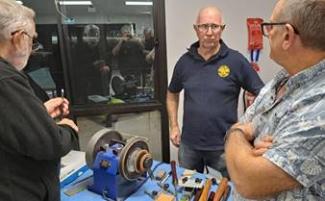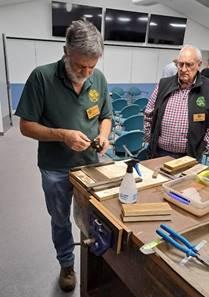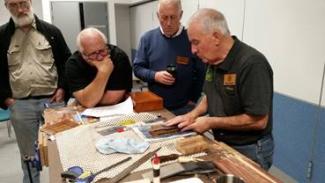Sharpening Round Table
We had three different workstations set up around the room, all showing different style of sharpening, I think everyone was spoilt for choice.
Station one, had Kevin set up with his “Tormek” sharpening system, which he uses to great effect every day keeping his turning chisels and gouges as sharp as possible.

It is set up with an aluminium CBN (Carbon Boron Nitrate) wheel on one side and a hard felt wheel on the other.
The CBN wheel is used to sharpen chisels without coolant, as they do not overheat and are excellent for removing steel, then having achieved the angle he wants he moves to the hard felt wheel and uses the finest polishing compounds to get an extremely sharp edge.
At our second area, Ian had set up his traditional sharpening station using diamond plates and Japanese wet stones in a variety of different grades.

To start, it is essential to ensure that the back of your chisel is flattened to remove the manufacturing marks, and you need to work your way from the course grades to the very fine waterstones to get a polished finish.
Using a sharpening gauge helps maintain a consistent angle, and adjusting it to suit the desired cutting angle, he then worked his way through the different grades of stone once again.
The result is two finely polished surfaces meeting at the cutting edge and being very sharp.
At our third station, Harry was demonstrating his preferred method for sharpening cabinet scrapers.
These are extremely useful tools, that come into their own when trying to get a fine finish on inlay work, flat surfaces and burls, in fact any timber that has multiple cross grain surfaces that cannot be planned without getting some “tear out”.

Harry uses them to finish decorative inlay in veneered surfaces, such as box tops as you can easily remove a miniscule shaving at a time without damaging the surrounding surfaces.
Using a jig and a file to make sure both surfaces are at 90 deg to each other, you then use the different grades of waterstone or diamond plate to polish both surfaces.
Then holding the scraper in the vice, use a burnisher at 5deg angle to turn a burr on each of the four cutting edges.
Using your thumbs to create a slight curve in the blade you can push the scraper along the surface of your timber removing a fine shaving each time.
Harry got everyone to give it a try and see the best way to get the results that they wanted.
Having sharp tools is at the very centre of everything that we, as woodworkers, try to do. When done correctly it makes the job so much easier.
Judging by the number of questions and discussions on what our members wanted to know, I think the evening was very successful and informative.
I am sure that everyone will have gone home, having learned more than a couple of new ideas that they will want to try out themselves, to ensure they can achieve a sharpness that can only be described as “Scary”
